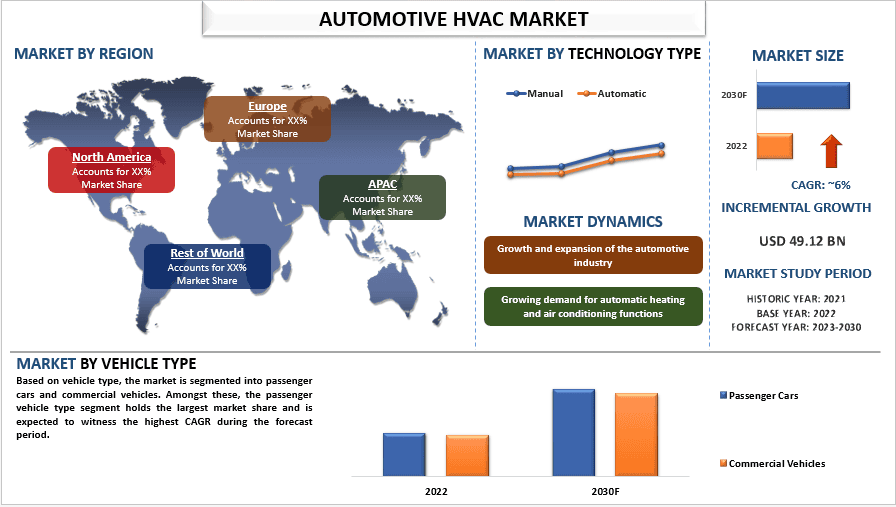- Home
- About Us
- Industry
- Services
- Reading
- Contact Us
Automotive HVAC Market: Current Analysis and Forecast (2023-2030)
Emphasis on Technology Type (Manual, Automatic); Vehicle Type (Passenger Cars, Commercial Vehicles); and Region/Country

Automotive HVAC Market was valued at USD 49.12 billion in 2022 & is expected to grow at a CAGR of 6% from 2022-2030 owing to increment in vehicle production along with increased demand for thermal systems and automatic climate control features in automobile. Moreover, the automotive HVAC market is expanding due to the high demand for eco-friendly refrigerants and coolants. For instance, in November 2021, the Marelli Corporation developed an indoor air quality (IAQ) filtration system that kills bacteria and viruses in vehicles and indoor environments. This system uses UV-A and UV-C light in combination with a titanium dioxide (TiO2) filter to kill airborne bacteria and viruses, including COVID-19, with an efficiency greater than 99 in 15 minutes. Market participants engage in mergers and acquisitions to expand their presence in the market. For example, in 2016, Denso has partnered with Toyota to develop Prius, a hybrid technology that promotes safety, energy efficiency, and green technology in vehicles. In addition, growing concerns about global warming have slightly affected the automotive HVAC market. As a result, many countries around the world have begun to take measures to reduce their carbon footprint, which could reduce demand for HVAC in this segment.
Some of the major players operating in the market VALEO, DENSO CORPORATION, MAHLE GmbH, HELLA GmbH & Co. KGaA, SANDEN CORPORATION, Sensata Technologies, Inc., JAPAN CLIMATE SYSTEMS CORPORATION, MITSUBISHI HEAVY INDUSTRIES, LTD., Hanon Systems, and Motherson. Several M&As along with partnerships have been undertaken by these players to facilitate customers with hi-tech and innovative products/technologies.
Insights Presented in the Report
“Amongst technology type, automatic segment is expected to grow with a significant CAGR during the forecast period (2023-2030)”
Based on technology type, the market is segmented into technology type and vehicle type. Amongst these, the automatic segment is expected to grow with a significant CAGR during the forecast period (2023-2030). This can be attributed to the growing demand for automated automotive HVAC systems including changing customer tastes and the growing popularity of high-end vehicles.
“Amongst vehicle type, passenger cars held a significant share of the market in 2022.”
By vehicle type, the market is segmented into passenger cars and commercial vehicles. Passenger Cars held a significant share of the market in 2022. Factors resulting from increasing disposable income and the availability of various financial programs are driving demand for this segment. In 2021, global auto sales was around 66.7 million units, compared with 63.8 million units in 2020. Due to these vehicle sales, the current OEM service includes air conditioning systems and advanced integrated HVAC in their proposed models. For instance, In October 2022, Polestar launched three of its electric SUV models in the global market. The SUV is equipped with an advanced climate control system to ensure passenger comfort during long journeys.
“Asia-Pacific has witnessed significant growth”
The automotive HVAC market has witnessed significant growth and beneficial performance in the Asia-Pacific region, the fastest-growing region worldwide. Due to the proximity of major auto manufacturers, the large production of automobiles, and the growing demand for vehicles in the countries that produce them, such as China, Korea, and India, the HVAC market Automotive in Asia-Pacific is sure to see significant growth. Government initiatives are to boost the automotive HVAC market next year to revive the auto industry. For example, the Indian government encourages foreign investment by offering courses in the automotive industry to commercialize discoveries. China’s production of passenger cars reached 996,000 units in April 2022, while sales stood at 965,000 units. This explains the decline in production and sales of 41.9% and 43.4% year-on-year, respectively. From January to April 2022, passenger car production fell 2.6% year-on-year, reaching a total of 6,494 million units.
Automotive HVAC Market Report Coverage

Reasons to buy this report:
- The study includes market sizing and forecasting analysis validated by authenticated key industry experts.
- The report presents a quick review of overall industry performance at one glance.
- The report covers an in-depth analysis of prominent industry peers with a primary focus on key business financials, product portfolios, expansion strategies, and recent developments.
- Detailed examination of drivers, restraints, key trends, and opportunities prevailing in the industry.
- The study comprehensively covers the market across different segments.
- Deep dive regional level analysis of the industry.
Customization Options:
The global automotive HVAC market can further be customized as per the requirement or any other market segment. Besides this, UMI understands that you may have your own business needs, hence feel free to connect with us to get a report that completely suits your requirements.
Table of Content
Research Methodology for the Automotive HVAC Market Analysis (2023-2030)
Analyzing the historical market, estimating the current market, and forecasting the future market of the global automotive HVAC market were the three major steps undertaken to create and analyze the adoption of automotive HVAC in major regions globally. Exhaustive secondary research was conducted to collect the historical market numbers and estimate the current market size. Secondly, to validate these insights, numerous findings and assumptions were taken into consideration. Moreover, exhaustive primary interviews were also conducted, with industry experts across the value chain of the global automotive HVAC market. Post assumption and validation of market numbers through primary interviews, we employed a top-down/bottom-up approach to forecasting the complete market size. Thereafter, market breakdown and data triangulation methods were adopted to estimate and analyze the market size of segments and sub-segments of the industry pertains to. Detailed methodology is explained below:
Analysis of Historical Market Size
Step 1: In-Depth Study of Secondary Sources:
Detail secondary study was conducted to obtain the historical market size of the automotive HVAC market through company internal sources such as annual reports & financial statements, performance presentations, press releases, etc., and external sources including journals, news & articles, government publications, competitor publications, sector reports, third-party database, and other credible publications.
Step 2: Market Segmentation:
After obtaining the historical market size of the automotive HVAC market, we conducted a detailed secondary analysis to gather historical market insights and share for different segments & sub-segments for major regions. Major segments are included in the report as technology type and vehicle type. Further country-level analyses were conducted to evaluate the overall adoption of testing models in that region.
Step 3: Factor Analysis:
After acquiring the historical market size of different segments and sub-segments, we conducted a detailed factor analysis to estimate the current market size of the automotive HVAC market. Further, we conducted factor analysis using dependent and independent variables such as technology type and vehicle type of the automotive HVAC market. A thorough analysis was conducted for demand and supply-side scenarios considering top partnerships, mergers and acquisitions, business expansion, and product launches in the automotive HVAC market sector across the globe.
Current Market Size Estimate & Forecast
Current Market Sizing: Based on actionable insights from the above 3 steps, we arrived at the current market size, key players in the global automotive HVAC market, and market shares of the segments. All the required percentage shares split, and market breakdowns were determined using the above-mentioned secondary approach and were verified through primary interviews.
Estimation & Forecasting: For market estimation and forecast, weights were assigned to different factors including drivers & trends, restraints, and opportunities available for the stakeholders. After analyzing these factors, relevant forecasting techniques i.e., the top-down/bottom-up approach were applied to arrive at the market forecast for 2028 for different segments and sub-segments across the major markets globally. The research methodology adopted to estimate the market size encompasses:
- The industry’s market size, in terms of revenue (USD) and the adoption rate of the automotive HVAC market across the major markets domestically
- All percentage shares, splits, and breakdowns of market segments and sub-segments
- Key players in the global automotive HVAC market in terms of products offered. Also, the growth strategies adopted by these players to compete in the fast-growing market
Market Size and Share Validation
Primary Research: In-depth interviews were conducted with the Key Opinion Leaders (KOLs) including Top Level Executives (CXO/VPs, Sales Head, Marketing Head, Operational Head, Regional Head, Country Head, etc.) across major regions. Primary research findings were then summarized, and statistical analysis was performed to prove the stated hypothesis. Inputs from primary research were consolidated with secondary findings, hence turning information into actionable insights.
Split of Primary Participants in Different Regions

Market Engineering
The data triangulation technique was employed to complete the overall market estimation and to arrive at precise statistical numbers for each segment and sub-segment of the global automotive HVAC market. data was split into several segments & sub-segments post studying various parameters and trends in the areas of the technology type and vehicle type in the global automotive HVAC market.
The main objective of the Global Automotive HVAC Market Study
The current & future market trends of the global automotive HVAC market were pinpointed in the study. Investors can gain strategic insights to base their discretion for investments on the qualitative and quantitative analysis performed in the study. Current and future market trends determined the overall attractiveness of the market at a regional level, providing a platform for the industrial participant to exploit the untapped market to benefit from a first-mover advantage. Other quantitative goals of the studies include:
- Analyze the current and forecast market size of the automotive HVAC market in terms of value (USD). Also, analyze the current and forecast market size of different segments and sub-segments
- Segments in the study include areas of the technology type and vehicle type
- Define and analysis of the regulatory framework for the automotive HVAC industry
- Analyze the value chain involved with the presence of various intermediaries, along with analyzing customer and competitor behaviors of the industry
- Analyze the current and forecast market size of the automotive HVAC market for the major region
- Major countries of regions studied in the report include Asia Pacific, Europe, North America, and the Rest of the World
- Company profiles of the automotive HVAC market and the growth strategies adopted by the market players to sustain in the fast-growing market
- Deep dive regional level analysis of the industry
Related Reports
Customers who bought this item also bought










